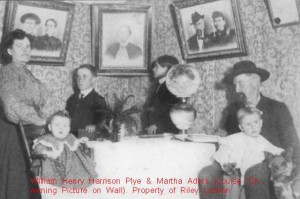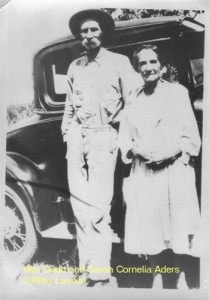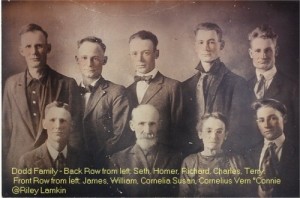Stories of Related Family’s

WILLIAM T. CHEWNING was born in Spencer County, Ind., December 15, 1846, being the tenth in a family of thirteen, viz.: Elizabeth (deceased), who married Henry J. Imboden; Philadelphia (deceased), who married Joseph S. Basinger; Sarah A. (deceased), who married Thomas Simons; Martha, who married John D. Hays, and is now Mrs. John D. Knott; Louisa, now Mrs. William H. H. Pyle; Berryman (deceased), Mary J., now Mrs. John J. Dotson; Maria F., now Mrs. George Miles; Hardin M., William T., Henry J., Joseph T. and Ira S., born to Hardin and Maria (Combs) Chewning, natives of Kentucky and Indiana. They were married in Spencer County, and now live in Clark Township, Perry County. They are members of the Methodist Episcopal Church, and are among the substantial citizens of the County. William T. remained at home until his marriage. He received a liberal education, and commenced to teach school in 1871, and has taught continuously, winters, until the present. He has been thus engaged in all over seventy-two months. He owns a farm of eighty acres. He was united in marriage to Miss Sarah M., daughter of Daniel and Nancy (Hyde) VanWinkle, of Clark Township, Perry County, October 30, 1873, and to them two children have been born: Nora A., born April 3, 1875; and Mandana A., born February 3, 1878. Mrs. Sarah M. Chewning was born February 23, 1851. Mr. Chewning is a member of the Methodist Episcopal Church, his wife of the Missionary Baptist Church. He is a Republican in politics, and is one of the leading teachers in the county.
“History of Warrick, Spencer and Perry Counties, Indiana – Clark Township” by Goodspeed Bros. & Co. – published in 1885
In the year 1861, he joined the Union Army in defense of the flag and country, serving as a private in Co. K, 81st infantry, serving with distinction throughout the war.
William Pyle – Find A Grave Memorial# 71747235, Greenwood Cemetery, Tell City, Indiana
Martha Aders – Find A Grave Memorial# 5765863
William Thomas Dodd and Sarah Cornella Aders
” BOOM-TOWN” DELAWARE, OK
There was the prairie, and a spring, some brush, a few trees, and railroad tracks. The train brought the man. It moved on, but he stayed. He and others built, houses, roads, streets. Others chose land parallel to the train tracks – he chose the land by the spring. His name was George W, Ifer, and he was one of the Founding Fathers of Delaware. He was either the first, or one of the first two people in Delaware.It was just a small village in the Midst of Oklahoma Indian Territory, but underneath it all was the underlying thread–oil. Men sat in front of their homes and places of business, and quietly watched the restless, energetic seeking of the oil men.Delaware grew–and then and over the years became home to 2 banks, 2 movie theaters, dime stores, drug stores, 13 saloons, barber shops, grocery stores, Churches, schools, a tomato canning plant, an ice house, hardware store, lumber yard, 3 blacksmith shops, a garage, service stations, 2 hotels, cafes, feed store, grain elevator, tile plant, bakery, newspaper, Bell Telephone Company, bus station, railroad depot, and inter-urban station. A U.S. highway, 169.The inter-urban was making several daily runs by 1915, from Parsons, Kansas, to Nowata, Oklahoma. They charged I cent a mile. There was also train service, and a bus.Suddenly something new began to be talked about, and its name was “Oil”, and with the oil came the workers and those who wanted to share in the profits–and Delaware became a “BOOM TOWN”, from 40 to 4,000. Among those who came were the Dodd boys; workers by day, the Dodd Boys’ Band to entertain night.Grandpa Will (Dodd) and Grandma Sarah (Aders), with their children who born in Missouri: Grace, Heck, Homer, Dick, Harvey, Fay, and Ted; and Jim who had been born in Indiana, decided to move to Oklahoma Indian Territory. So the covered wagons were prepared, belongings packed, stock gathered, and the family started out. Uncle Harvey remembered it as a trip of hardships.They left behind them in Indiana and Missouri their brothers and sisters, aunts and uncles, and Grandma left her mother, Margaret Peggy (Brock) Aders, Richard Elzey Dodd, John D. Dodd, Phoebe Madora Blake, Rosilla Ardilia Dixon, John Will Aders, Barbara Splater, Millie Catherine McKim. They left Millie and John Green and grand-daughter Letha. And another tiny grave for Millie and John’s Barbara. Plus the little graves for their Anne Lora and Johnny, and the larger ones for James Elzey and Becky.Continuing on to “BOOM-TOWN” DELAWAREThey left Missouri after Ted was born Jan., 1900 in Mo., and were In Ochelata, Oklahoma Indian Territory by 1902, so thus were in the right place at the right time, and oil became a part of Dodd history.As far back as we have checked, Dodds were farmers, or worked on farms. One was in manufacturing, and one was a store keeper. The rest were farmers, and farmers, and farmers. This all changed in this one family within a 5 to 10 year span. All of farmer Grandpa’s sons changed from farming to oil field work, except Jim. So the Dodd boys went to Delaware, and there they stayed, or nearby.Oil had been “discovered” in Delaware in 1906. Heck and Rosie were married in 1907 in Ochelata, Indian Territory, and went to Delaware. Dick was there by 1911. Harvey and Homer by l9l5. Ted and Connie followed in the oil business as soon as they were old enough.Levi “Woody” Robbins owned vast Indian Lands northeast of Delaware, and his land was where a lot of the oil was. He left this land to his 4 daughters, one of whom was Aunt Lona,Uncle Dick’s wife, and oil is still being pumped on her land today. Another daughter was Dora Faulkner, and in the “EXTRA’ about Nowata County oil it tells us: “The Faulkner Ranch north of Delaware produced more oil per acre than any other water flood in the world at that time.” Also, “The Henderson Gasoline Plant, east of Delaware, was the largest in the world.”Connie was a pumper, and lived at Red Eagle Camp near Pawhuska for years. Virginia and Anna Faye wanted to “walk the shackle-rode’ with him and we both wore white dresses. He later moved to Delaware and worked for Pure Oil Company,Dick was a driller, and a good one. Heck worked for an Independent Oil Company east of Delaware. Homer worked at Delaware and Shidler oil fields. Harvey was a pumper, and worked for “pretty Prairie”, later called “Gypsy Oil”, and was finally absorbed by “Gulk Oil’. He was with the same company for 35 years. Ted was a roustabout, was in charge of a pipe-line gang, and was a pumper, at different times.Pure Oil bought Delaware Consolidated, but they still operated more or less as they had as Delaware Consolidated. Oil companies still in the Delaware area in the 1940’s and later were: Sinclair, Pure Oil, Delaware Consolidated, Hannon and Whitehill, Baysinger, Mike Shufflin, Warren Oil, and an Independent Oil Company run by Alvin Edwards.After the wells were drilled, the pipe lines laid, the tanks and power houses set, the excitement died down–most of the oil people moved on. Just leaving the pumpers, guagers, and essential personnel.There were the power houses, with their big fly wheels, the other machinery and their noise. Each well was connected to a power house by shackle-rods. These were iron rods, mostly on the ground, though different sized trestles were set under them at low spots to keep them comparatively level. The rods went forward a little, and then back a little, forward, back, At the power house each well could be hooked on, it’s shackle-rod attached to the power house machinery, and thus the wells were pumped. -The power houses were very noisy, but one soon got used to the sound, and if the power house machinery stopped at night, everyone would awaken, even small children. The shackle-rod lines had to be maintained, weeds kept back, and the trestles kept oiled, another duty for the pumper.If you were a pumper you were furnished a lease house, which could be a single unit, or part of a group of houses. They were usually all the same. Connie’s at Red Eagle was part of a camp–Ted’s at Webb City was a single.I doubt if there is one Dodd farmer in Oklahoma, but bet there are still some in Ind. and Mo. Grandpa Dodd “saw it happen”, so could more or less take it for granted, but I wonder what James Elzey would make of all this?Today in 1992, Bartlesville, near Ochelata, is the home of Phillips Oil Company. in 1923, Phillips Headquarters were at Okesa, “Okesa” is an Osage word meaning “halfway”. It was halfway between Pawhuska, Osage Indian Capitol, and the Cherokee Boundary. Okesa had stores, churches, a school, and service stations in the 1940’s and 1950’s. Today it just has houses. Okesa was also headquarters for the Al Spencer Gang which “operated” in this area. Frank Nash was co-leader with Spencer, and later Frank Nash teamed up with “Pretty Boy” Floyd, an Oklahoma-born outlaw.

